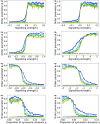Emergent order in epithelial sheets by interplay of cell divisions and cell fate regulation
- PMID: 39401252
- PMCID: PMC11501039
- DOI: 10.1371/journal.pcbi.1012465
Emergent order in epithelial sheets by interplay of cell divisions and cell fate regulation
Abstract
The fate choices of stem cells between self-renewal and differentiation are often tightly regulated by juxtacrine (cell-cell contact) signalling. Here, we assess how the interplay between cell division, cell fate choices, and juxtacrine signalling can affect the macroscopic ordering of cell types in self-renewing epithelial sheets, by studying a simple spatial cell fate model with cells being arranged on a 2D lattice. We show in this model that if cells commit to their fate directly upon cell division, macroscopic patches of cells of the same type emerge, if at least a small proportion of divisions are symmetric, except if signalling interactions are laterally inhibiting. In contrast, if cells are first 'licensed' to differentiate, yet retaining the possibility to return to their naive state, macroscopic order only emerges if the signalling strength exceeds a critical threshold: if then the signalling interactions are laterally inducing, macroscopic patches emerge as well. Lateral inhibition, on the other hand, can in that case generate periodic patterns of alternating cell types (checkerboard pattern), yet only if the proportion of symmetric divisions is sufficiently low. These results can be understood theoretically by an analogy to phase transitions in spin systems known from statistical physics.
Copyright: © 2024 Philip Greulich. This is an open access article distributed under the terms of the Creative Commons Attribution License, which permits unrestricted use, distribution, and reproduction in any medium, provided the original author and source are credited.
Conflict of interest statement
The authors have declared that no competing interests exist.
Figures





References
MeSH terms
LinkOut - more resources
Full Text Sources

